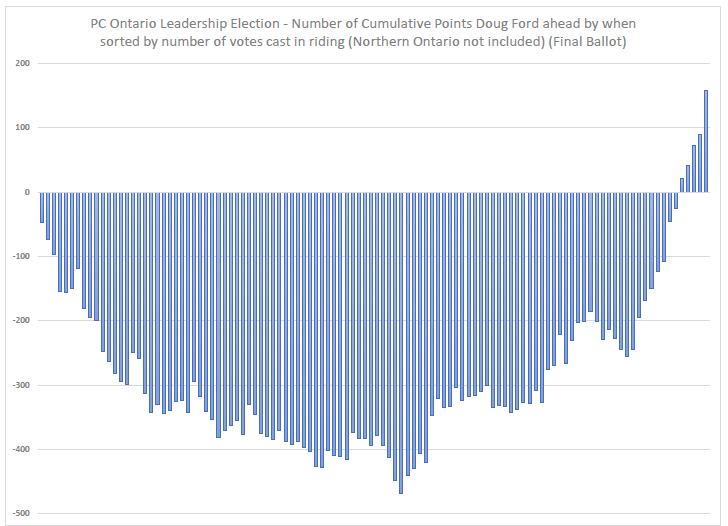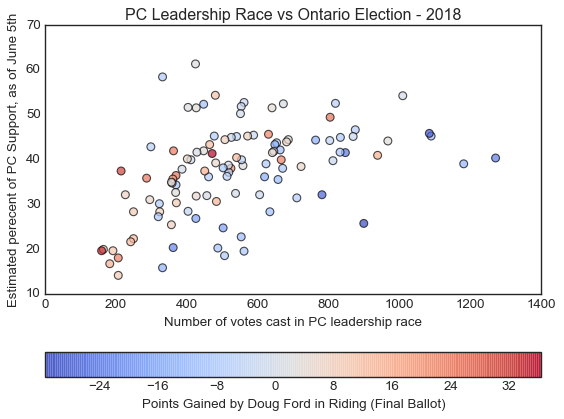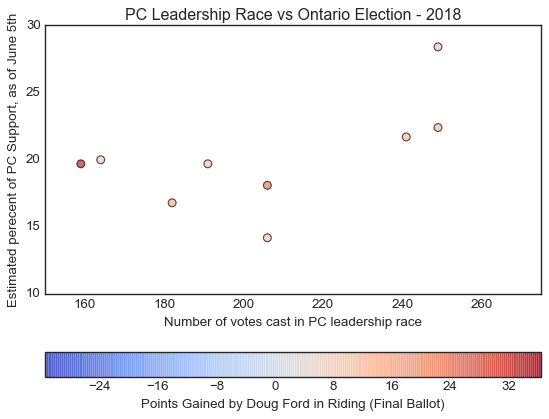I have always had an interest in politics. Although my allegiances have
changed from election to election, I have also had an interest in the
process itself. The machinations of how someone is elected leader of
their political party, and then as leader of their province/country
has always held some interest for me.
So it caught my attention one day when I saw that my friend Ed Brown
was writing about the Ontario PC Leadership race, and how with it's
convoluted system, it put all of the power into the hands of ridings
with smaller amounts of votes.
I decided to do a deeper dive into the methodology of how the PCs in Ontario
(and in Canada) decide on who their leader is. I guess my study of
how leaders were chosen had slipped! I remember the days of leadership
conventions from the past with multiple rounds of voting. Someone would
be eliminated and then the race would be on to garner the support of the
eliminated candidates supporters. It could be a long and yes, sometimes
dreary affair. I assumed that was still the way the voting was done - but once
I did the research I came to realize how wrong I was!
At the current time the PC party of Ontario (and Canada) uses a ranked
ballot in deciding the leadership of the party. When indicating your
choice for leader of the party you can also indicate a second or third
choice. All of the long hours waiting for voting and counting to happen
at past leadership conventions is a thing of the past. Votes for each
round can be tabulated quickly, the lowest point getter is eliminated,
and then the next round can be tabulated, until a winner is determined.
At this point, it looks like a good system from a standpoint of how
many hours and how much expense is saved in the process of selecting
the leader. But, in the purview of making things "fair" the PCs have
introduced a wrinkle to the system - each riding only gets a maximum
of 100 "points" towards the vote. If 100 members or less from that
riding vote then each vote is counted as 1 point towards the candidate
(This happened in 3 of the 124 ridings in the 2018 leadership vote - all
all of them from Northern Ontario). For ridings with over 100 voters
then the 100 points are allocated on a percentage basis. 40% of the
vote in that riding translates into 40 points. Individual members in
ridings like Don Valley West that have a large voting base (1,334
members voted in the leadership race) have much less say than an
individual in a riding with a small membership base like Humber River -
Black Creek (159 members voted).
Looking at the face of it, something seemed funny to me about
weighting the votes by riding. Especially since ridings are
designed to have approximately the same number of people in them.
Wikipedia states that the Don Valley West riding had a population
of 123,200 in 2011, and Humber River - Black Creek had a population
of 108,198. Don Valley West having 13.8% more people does not
explain why 8.4 times the number of people voted in the leadership
race from Don Valley West than from Humber River - Black Creek.
I started looking at whether the ridings with less voters in
the PC leadership race did have an effect on the overall winner
of the race. The leadership race was a very tight one. Once the
final round was complete, Doug Ford won by 153 points (1.24% of
all the points). On an actual vote basis, Christine Elliott
received 3.47% more of the ballots cast, so Doug Ford was
definitely able to take advantage of the points from areas
where there were a smaller number of votes cast.
Once I was able to gather the raw numbers (from Wikipedia), I
did an analysis of where the points for each candidate came from.
Looking at each region, I came to the realization that the 14 ridings
from Northern Ontario were effectively a wash. Elliott won the whole
region by 5.77 points. No candidate won any riding in the region
by more than 24 points. I decided to leave the region out of the
analysis to be able to drill down further in Southern Ontario.
One of the first analyses that I did was a look at cumulative
points won for each candidate when sorting the ridings by number
of votes cast. I think it tells an interesting tale:

For the top 51 ridings by numbers of votes cast Elliott had 54%
of the points. Over the next 53 ridings Ford collected 51.7% of the
points, but then in the 13 ridings with the smallest number of votes
all of them had a Ford majority, and gave him 65.9% of their points.
This group of ridings represented only 4.6% of the votes cast, but it
swung the election. Outside of these ridings Ford lost by 267.65 points
but within these 13 ridings he gained 414.2 points to win the race.
There are various reasons why Ford could have won these areas
by such a great margin. Possibly the Ford campaign was better at
targeting these ridings that were going to have an overweighted
effect on the final results. The hypothesis that I came away with
still bothered me though - I believed that the reason why these ridings
we so under represented by membership votes was due to them being in
ridings where there is not a large amount of PC support. If that is
the case, then the PCs are giving the power of "kingmaking" to the
members in ridings where there is minimal chance of a PC being elected!
I was able to find the latest projections of how the Ontario
provincial election is going to turn out on www.tooclosetocall.ca.
Once I compiled the data from the PC leadership vote and the Ontario
election projections I was able to come up with this chart:

The bottom left corner was very interesting to me. Zooming in
we get the following points:

The points represented are 9 different ridings: Davenport, Hamilton Centre
Hamilton East—Stoney Creek, Hamilton Mountain, Humber River—Black Creek,
London—Fanshawe, Windsor West, Windsor—Tecumseh and York South—Weston.
All of the ridings have a snowball's chance in hell of having a PC
candidate elected in the Ontario election, yet these 9 ridings when
given equal weighting under the PC leadership election scheme gave
275 points more to Ford than to Elliott - more than enough to swing
the leadership to Ford.
The way the PC leadership elections are run leads to the real
possibility that the leadership is decided by the areas where there
is no real support for the PCs in general. Just this scenario seems
to have happened in the PC leadership election in 2018. This has
made the PC members in these 9 ridings the unlikely kingmakers that
may have chosen the next premier of Ontario.